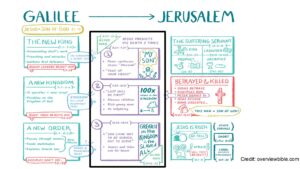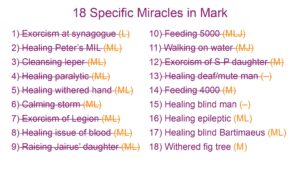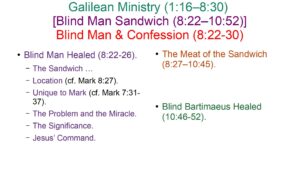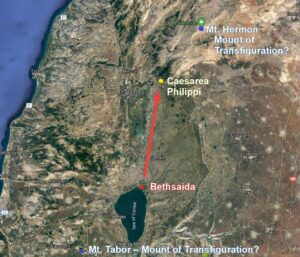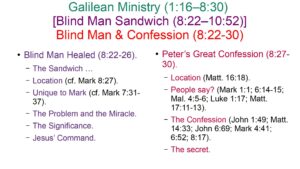The Ministry of Jesus in Galilee
Mark 1:16–8:30
A New King (1:16–3:6).
Kingdom is Near (1:15)
Popularity (1:16-45).
Conflict (2:1—3:6).
Jewish Leaders Reject Him (3:6)
A New Kingdom (3:7—6:6)
Kingdom Has Small Beginnings (4:3)
Continued Conflict (3:7-35).
Parables (4:1-34).
Identity (4:36—6:6).
Jesus’ Town Rejects Him (6:6)
A New Order (6:7—8:21)
Beware of Herod & Pharisees (8:15)
Confession (6:7—8:21).
Disciples Don’t See (8:18)
Blind Man Sandwich (8:22–10:52).
Blind Man Healed (8:22-26).
Here we see two events where a blind man is healed.
Earlier we saw the Pharisees and the Herodians plotting to kill Jesus, then we saw those in Jesus’ hometown rejecting Him.
We had just seen the Pharisees refusing to see because of their hypocrisy.
Then we see the disciples somehow missing the obvious because of their hard hearts.
All of these groups were spiritually blind, so Jesus heals a man who is physically blind.
Then some things happen which should make it very clear, the meat of the sandwich.
Then we see blind Bartimaeus’ sight restored.
Location – Bethsaida Julias. This is evident because they are on their way to Caesarea Philippi just north
 of their location along the Jordan River (8:27).
of their location along the Jordan River (8:27).Unique to Mark.
This is the only other miracle completely unique to Mark.
The other was the deaf man with a speech impediment.
It is quite an interesting miracle, and its placement is very telling in the overall narrative.
The problem and miracle.
There are some similarities between this miracle and the other miracle unique to Mark, at least three.
Some people must have heard of Jesus and brought this blind man to see Him and be healed – similarity #1.
Jesus takes him away from the crowds – similarity #2 (though this appears to be more out of town entirely).
Jesus uses His own saliva and touches the problem area – similarity #3. But that’s where the
 similarities end.
similarities end.One more remarkable thing happens—Jesus doesn’t heal the man right away.
No other recorded miracle of Jesus required a second attempt. Why do you suppose that Jesus didn’t heal this man right away?
Was the faith of the blind man too weak? Did Jesus’ power falter here? I don’t think so and certainly not…. So why?
The significance.
Right before the eyes of the disciples, Jesus performs a miracle that shows their lack of understanding.
This is hot on the heals of Jesus chiding them for just that, despite the many miracles He had performed, despite His teachings, and His compassion.
The disciples couldn’t quite see the truth about Jesus, but they were beginning to.
And soon, just as this man eventually had his sight fully restored, they would see clearly as well.
They might see a glimpse of this by the time of the coming confession, but they wouldn’t fully realize it until the Holy Spirit came down in Acts 2.
Jesus’ command.
Jesus then tells the formerly blind man not to go into the town, and as some manuscripts say, not to tell anyone in the town.
Obviously, if he doesn’t go into the town, he wouldn’t be able to tell anyone about it.
As we have noted earlier, the healed (or even resurrected) individual often finds it difficult to keep the miracle to themselves.
Sometimes it’s impossible because everyone knows the leper had leprosy and is now healed, or the girl had died but is now alive.
If the formerly blind man does not go into the town, then it will be easier to keep this secret.
There is no indication whether or not he obeyed Jesus, but I think that he did.
Jesus wanted to have some time alone with his disciples at Caesarea Philippi, then especially as they moved on to the Mount of Transfiguration (Mt. Hermon?).
The Meat of the Sandwich (8:27–10:45).
Peter makes the Great Confession.
Jesus predicts His death three times.
He talks about that kingdom of God, that it is coming soon.
Jesus is transfigured before them and the Father endorses Him over Moses and Elijah.
John the Baptist is finally revealed to be the return of Elijah.
Jesus heals an epileptic.
He teaches on forgiveness, humility, service, marriage, and even on hell.
He reveals the whole reason why He is here: to die and be raised up.
With all that revealed, Jesus heals another blind man.
Blind Bartimaeus Healed (10:46-52).
Bartimaeus already sees the truth while still being blind physically.
He knows Jesus is the Son of David, a term indicative of the Messiah.
So Jesus restores his sight because of his faith.
Now his physical state resembles his spiritual state.
Jesus opened his eyes as He is opening the eyes of His disciples.
At that all starts where this section ends:
Peter’s Great Confession (8:27-30).
Founded by Philip the Tetrarch, named after himself and Caesar.
It was his administrative capital in his tetrarchy.
What’s important—it was at the foot of Mt. Hermon.
Mt. Hermon was the tallest mountain in the region.
When Peter makes his confession, recall Matthew records that Jesus said He would build His church upon this rock (Matt. 16:18).
We understand that rock to be that great confession here juxtaposed with the imagery of the “high mountain” called Mt. Hermon.
People say?
Mark, for the most part, tries to leave the answer to this question up to the reader.
He announced it at the very beginning of this book (Mark 1:1).

So far, he has laid out his case for Jesus up to this point.
Earlier, he noted what others said around the time of the Limited Commission (Mark 6:14-15).
Clearly the disciples heard tell of what other people thought about Jesus.
Jesus asks, likely to establish a baseline, what they thought.
Of course Jesus had amassed a great deal of fame and some controversy over His identity.
Some said John the Baptist, particularly Herod Antipas.
Recall, he thought John had risen from the dead.
Others thought it was Elijah, a powerful prophet in the OT.
Recall, Elijah had never died, but was taken up in a chariot of fire (2 Kgs 2).
After all, Elijah was prophesied to return before the coming of the Messiah (Mal. 4:5-6).
Apparently the general populace was not fully aware that this was already accomplished through John the Baptist (Luke 1:17; Matt. 17:11-13).
“One of the prophets,” or just a prophet. This is evident because of the miracles He was able to perform, and His wonderful teaching.
